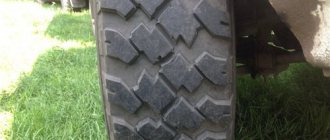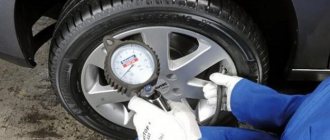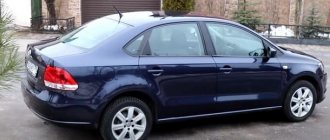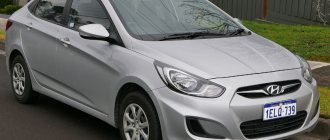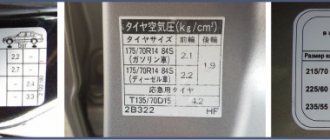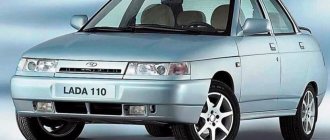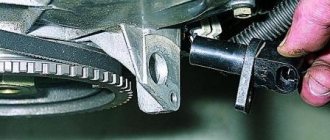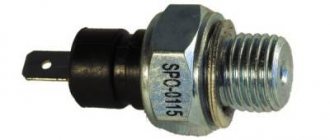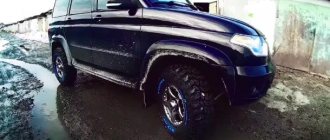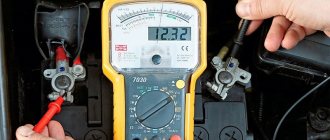The manufacturer sets the recommended tire pressure for Lada Kalina at 2.2 - 2.3 Atm. For front and rear axle. The manufacturer specifies reference values used under rated operating conditions. This:
- Outboard temperature within +20-25°C;
- Full load no more than 300 kg;
- Asphalt road surface of adequate quality.
In reality, indicators may differ significantly from those set by the factory. Users have calculated for themselves certain adjustments to the optimal pressure. In summer, during extreme heat, it is recommended to lower the tires by 0.2-0.3 bar. This is especially true when driving on the highway. Due to strong friction, the wheels heat up, which leads to the expansion of the air inside the cylinder.
In winter, the reverse process occurs. For every 10°C decrease in temperature, the pressure in the wheels drops by approximately 0.2-0.3 Atm, which indicates the need to inflate tires before leaving with a reserve.
Separately, you should consider the option of traveling on a bumpy road or dirt road. Here, hard tires can make the ride less comfortable. On the other hand, broken asphalt and under-inflated slopes cause cuts in the side of the slope. It is recommended to monitor the operating pressure whenever the road conditions change.
Separately, you should consider the difference in the tires themselves. Different models are distinguished by softness or hardness. On ROSSAVA and Continental tires with similar tread, the optimal pressure will differ slightly due to the difference in rubber composition.
Tire pressure is very important
In this article we will talk about what the tire pressure of a car should be.
During the design and production of cars, automakers select and test a wide variety of tire options individually for each model. At the same time, they are guided by the weight of the car, its dimensions, body style and a number of other criteria.
When choosing the optimal air pressure in tires, special attention is paid to speed and load capacity. Typically, the manufacturer's recommended pressure is indicated on the inside door pillar, in the owner's manual, on the inside of the fuel tank cap, and sometimes in the engine compartment.
Typically, the manufacturer's recommended pressure is indicated on the inside door pillar, in the owner's manual, on the inside of the fuel tank cap, and sometimes in the engine compartment.
We must not forget that there are two types of tire pressure values. One of them is designed for movement with a normal vehicle load, and the second - with a maximum vehicle load.
How to check tire pressure
Today the level can be checked at almost any gas station that provides tire inflation services. There are also digital pressure meters that are made in the form of keychains. And there is also the good old manual pressure gauge, which has been in use by motorists for quite a long time; in any case, the owners of Zhiguli cars definitely have them. Sometimes pumps are equipped with this device.
You need to check tire pressure when they are cold. An accurate measurement result can only be obtained if your car has been parked for at least two hours or you have driven it a short distance.
If you need to check and inflate your tires after a long journey, then you should add 0.3 bar to the recommended pressure (1 bar = 0.1 MPa).
Then be sure to recheck the levels after they have cooled completely. If the tires are hot, it is not recommended to lower their pressure.
Even slight overheating, not to mention insufficient pressure, can cause damage at any time.
Insufficiently inflated tires begin to rapidly wear out the side surfaces of the tread, and fuel consumption also increases. But if you overinflate the tires, the tread begins to wear out in its central part.
In other words, excess or lack of pressure greatly reduces the safety and durability of tires.
In this regard, it is necessary to check tire pressure at least once a month or when there is a sudden change in air temperature.
Also, remember to inflate the spare tire from time to time, keeping it to the maximum recommended level.
Kolodiychuk Andrey, especially for ByCars.ru
When a decrease or excess of pressure is allowed
There are situations in which violating the manufacturer’s recommendations is only for the benefit of the car. We are now talking about the contact patch, which increases with decreasing pressure in the tread and vice versa (decreases with increasing). When might this come in handy?
When driving on soft ground
By reducing the pressure by about one-fourth, you will thereby increase the contact patch by almost one and a half times. Accordingly, the movement will be easier, since the pressure on the soil will decrease.
Thanks for subscribing!
When driving on wet asphalt
By increasing the pressure, you will reduce the contact patch, which will reduce the risk of so-called aquaplaning. However, it should be noted that this rule does not apply to more modern tires, since they are initially designed to drain water.
When moving on rocky ground
In this case, the pressure can be increased, which will reduce the likelihood of damage to the tire sidewall. Don’t forget to return your blood pressure to normal after you’ve completed a difficult section of the trail.
To improve handling
By increasing the pressure, you can improve the car's handling and also reduce fuel consumption. However, you should not get too carried away with this, otherwise, in addition to all the advantages, you can get one rather significant disadvantage - an increased risk of a tire explosion.
Remember that blood pressure tends to decrease gradually, day after day. In summer it decreases a little more, and in cold weather, on the contrary, more slowly. Another important nuance is that some car models have different pressure levels on different axles. Do not forget to control the pressure and pump up the tires if necessary, and then driving will be safe for both you and others.
Optimal car tire pressure
The main task of car tires is to provide effective traction between the car and the road. With normal air pressure in the tire, the load in the contact patch of the wheel with the road is distributed evenly, due to which tire wear occurs evenly, the car handles well and fuel consumption is within normal limits.
There are three possible scenarios in which the tire pressure will not be optimal:
- Increased pressure (tires overinflated);
- Low pressure (tires underinflated);
- Different pressure in all wheels.
Check the tire pressure with a special tire pressure gauge. This should only be done on cold tires, that is, before leaving the parking lot or garage.
If deviations from the normal pressure are detected in any of the tires (see the table below for what pressure should be in the tires of your passenger car), such a wheel must either be inflated or excess air released from it - that is, the pressure must be adjusted to norm. In one of our articles, we already talked about which car compressor is best for inflating tires.
It is worth noting that the tire pressure in winter should be exactly the same as in summer. But due to the sharp temperature change, in winter, monitoring the air pressure in the wheels needs to be approached more responsibly.
It is better to inflate your tires outside. Also, do not forget to check the tire pressure when there are significant changes in ambient temperature, and if necessary, adjust it:
- if it gets cold outside, the pressure in the tires will decrease,
- and when it gets warmer, it will rise.
It should also be remembered that while the car is moving, the tires heat up, the air in them expands, and the pressure increases, and the handling and braking properties change.
Increased tire pressure
With increased tire pressure, the load at the point of contact of the wheel with the road acts to a greater extent on the central part of the tire tread, thereby causing uneven wear of the tire.
On overinflated wheels, the car brakes worse! This happens because if the tires are overinflated, the contact patch with the road decreases, which means the friction force that keeps the car from sliding decreases. At the same time, the braking distance increases noticeably.
In just twenty minutes of driving, taking turns as aggressively as possible, the pressure in the car’s tires can increase by 0.5 atmospheres. And on long trips at high speed, the pressure in the tires can increase to 4-5 atmospheres. And modern tires are designed for this.
But if the tire has a hernia or cut, it can heat up and explode while driving. But on the road it’s a disaster.
Low tire pressure
Wheels lowered to just half an atmosphere change the behavior of the car and become unusable much earlier than expected. When the pressure is low, the load on the tire surface is distributed unevenly. In this case, the sidewalls of the tire where the tire contacts the road are subject to increased wear.
The sidewalls of flat tires are softer and bend when you turn the steering wheel. The trajectory of the wheel and tire do not match, so the car responds to the steering wheel late.
Moreover, if the tire pressure is reduced, the wheel may even come off during a sharp turn.
Therefore, it is very important to regularly check tire pressure and maintain it within normal limits.
This is especially true in winter, since in cold weather the tire pressure can easily drop by 0.3 (or even 0.5) atmospheres.
What does it depend on
The main factor influencing the tire pressure of the Lada Kalina is temperature. The higher the temperature, the greater it is. The temperature depends on external weather conditions and driving style (with aggressive driving, the tires heat up faster, so the indicator increases even more). This is typical in summer when the air temperature is very high.
Normal tire pressure "Lada Kalina"
In winter, it’s the other way around – after pumping up the required pressure in a warm garage and going outside in sub-zero temperatures, drivers notice a drop in performance. The wheels need to be inflated again.
Temperature affects not only the pressure in tires, but also the structure of the tire itself, which changes when it gets colder. Because of this, the tire may leak at the contact point between the disc and the tire.
Wheel rubber manufacturers
For the Priora, Granta (liftback) or other Lada model, you can find the following types of tires on the market:
- Matador 175/70 R13 Nordicca MP 52 82T. Used for driving in cold seasons. The product performed well on dry and wet surfaces, ice and snow. If you use the product for a Granta (sedan or liftback), inflate the wheels to 2 atm according to the manufacturer’s instructions;
- Bridgestone 175/70 R13 Blizzak Revo GZ 82s. Represents a group of studless winter wheels with a soft tread compound. Equipped with a large number of slats. For Priora, a pressure value from 2 to 2.5 atm is suitable, which is allowed by the characteristics of the product of this company;
Bridgestone Blizzak winter tires
- Kleber 175/70 R13 Viaxer 82T. The improved rubber composition is intended for travel in the warm season. It has precision control and is equipped with drainage channels. The optimal pumping value for such products is 2.2 atm;
- Nokian 175/70 R13 Hakkapeliitta R2 82R. It has a herringbone pattern and is also equipped with slats. It is characterized by soft rubber in the tread and does not accumulate snow in the contact patch with the road surface. Inflates from 2 atm, which is suitable for “Granta”;
Winter tires Nokian Hakkapeliitta
- Fulda 175/70 R13 Ecocontrol 82T. Designed for summer use, made in Poland. The manufacturer allows tire inflation up to 2.5 atm;
- Barum 175/70 R13 Brillantis 2 82T. Recommended for use on Grant, Priora and other varieties of Lada in terms of price and quality ratio.
Features of wheel inflation
To ensure comfortable and safe driving of the Kalina in winter and summer, it is necessary to measure the degree of tire inflation with a mechanical or electronic pressure gauge.
You can find the recommended tire inflation value on a Lada on the body on the driver's door or on the glove compartment door.
Allowable air pressure in the tires of Lada Priora cars.
You will also see the optimal inflation mode in the table given by each tire manufacturer. The values in it are adjusted depending on:
- number of passengers, luggage;
- car model (indicators for Grants, Priora and other Lada models differ depending on their weight).
Remember that the same pressure must be maintained in both winter and summer.
Recommended tire pressure for Lada Granta cars
However, there is a nuance: if the Lada Kalina is parked for a long time in a warm garage or service station, prepare for a slight decrease in tire inflation after driving out into the cold.
Thus, you will have to inflate your car tires more often during the cold season.
The standard value of pressure in the front and rear wheels for the Lada Kalina should be as follows:
- for the VAZ-1117 model - 1.9 atm on the front and rear wheels when partially loaded, as well as 1.9/2.1 on the front and rear wheels when fully loaded;
- for the VAZ-1118 model - 1.9 or 2 atm at partial load, as well as from 1.9 to 2.2 atm at full load on the front and rear wheels, respectively;
- for the VAZ-1119 model - 2 atm at partial and 2/2.2 atm at full load on the front and rear wheels, respectively.
Allowable air pressure in the tires of the Lada-Kalina
Experts call a partial load of a Priora, Granta or another Lada model when up to 3 people are in the car, provided the trunk is unloaded. Full load - the maximum possible number of passengers in the car and cargo in the trunk (with a weight of less than 50 kg).
If you want to know the tire inflation levels, wait until they cool down (after a long ride or exposure to the sun). This will make the pressure gauge results more accurate.
Lada-Kalina tire sizes
Tire pressure "Lada Granta"
Cars from the domestic manufacturer Lada Granta are popular even today. This is because their price is low, and even an average family with an average income can afford such a car. The price-quality ratio is approximately the same, although some Lada models still receive a lot of negative reviews on the forums. Owners of such cars often do not think about what pressure standards must be observed. They don’t even know where such parameters are indicated. Similar information can be found in the instruction manual. There the manufacturer describes which indicators are suitable for which modification. Information about the tire sizes suitable for such cars and the number of atmospheres for each option are also provided.
Tire pressure gaugeIn 13-inch tires, the permissible level at partial load is 1.9 atmospheres. And when fully loaded, they increase to 2.1 bar on the rear tires. But 14-inch wheels need to be inflated to 2.0 bar. At maximum load of the car, the indicators should be 2.2 Bar on the rear axle tires. The total carrying capacity of the vehicle is 475 kilograms.
On a note. After your car tires are inflated at a tire shop, it is advisable to check the air level with your own pressure gauge upon arrival home.
Very often, employees of such organizations do not bother and pump all tires to 2.0 bar. And such indicators can be overestimated or underestimated for a particular brand of car. Therefore, the pumping should be controlled independently. A lot of problems can arise due to incorrect pressure. For example, under-inflated tires can lead to:
- quick erasing of side protectors on rubber;
- overheating of tires and their premature deterioration;
- impaired vehicle control, especially when turning;
- excessive fuel consumption.
There are some advantages to underinflated tires:
- soft running of the car;
- no noise or rattling inside the machine.
But the disadvantages clearly outweigh all the advantages. In order not to waste money on new tires later, it is better to adhere to acceptable standards.
Overinflated wheels also do not have a very good effect on the condition of the components and parts of the car:
- the suspension wears out quickly;
- the middle tread on the rubber wears off;
- the car drives hard;
- You can hear a rattling sound in the cabin and feel all the bumps and potholes on the road.
The only advantage is fuel economy, but you shouldn’t be too happy about this fact. The disadvantages here clearly outweigh all the advantages.
Important! It is necessary to measure pressure only after the car has been idle for three hours after a trip, with cold tires.
Lada tire pressure table
How to measure blood pressure correctly
There are only two methods here - either a car or a stationary pressure gauge is used to check (you can find it at a gas station or in a tire shop).
First of all, you need to make sure that the tire is “cold”, since you cannot reduce the pressure in “hot” tires. When the car moves, the rubber heats up, and, accordingly, the pressure increases - this also needs to be remembered.
What should be the tire pressure for different situations?
The tire pressure of the Lada Kalina station wagon/hatchback is regulated by the LADA concern. It is indicated in the technical specifications of the machine.
The optimal pressure in the Kalina wheels is shown in the table, depending on the load.
| Wheel size | Tire pressure (bar) without cargo in the trunk and no more than 3 adults (front/rear) | Tire pressure (bar) with cargo in the trunk (50 kg) and more than 3 people (front/rear) |
| 175/70R13 | 1.9/1.9 | 1.9/2.1 |
| 175/65R14 185/60R14 | 2.0/2.0 | 2.0/2.2 |
What to do if your tires lose pressure
Over time, the driver begins to notice that the Kalina’s wheels are going flat. This happens for various reasons.
- Inspect the disc, which may have become deformed as a result of a serious impact. Because of this, the tire does not fit tightly to the rim. This is where air leaks occur. It's hard to notice. You can recess the wheel and see where the air is leaking from, or go to a tire shop, where they can identify the problem area and straighten the disc.
- Depressurization may occur in the nipple. The reasons for this are dirt and mechanical damage. Blowing out the spool or replacing it completely will help.
- The most unpleasant reason for air bleed from wheels is a puncture. You may not notice how you hit a sharp object that remains in the tire. Air will gradually leave this place. Hitting curbs or deep holes increases the risk of a side puncture, which will also lead to a gradual decrease in tire pressure.
- The tire may leak air due to the formation of microcracks at the points of contact with the disc. The reason is old tires or improper storage.
A flat tire on a Lada Kalina
If the puncture is small and only the tire is damaged, then this place can be sealed with special tourniquets. Such repair kits can be found in automobile stores. It's easy to do:
- Find the puncture site by soaking the wheel in water or soaping it. The place where the bubbles come out is the puncture.
- If you find a foreign object at the puncture site, remove it.
- Take the awl-file that comes with the kit. Use it to clean the puncture site.
- Having prepared the tourniquet from the repair kit, forcefully push it into the puncture.
- Cut off the remaining rope.
At this point, the tire repair can be considered complete.
The worst situation is when a side cut is formed. Few car repair shops will undertake the repair of such a tire. This is due to the fact that when a side cut occurs, the metal cord breaks, which reduces the overall strength of the tire.
Even if it is repaired, you will soon have to return to the service station, since the side cut will manifest itself again.
This can lead to the puncture site rupturing while driving, which creates a risk of an emergency.
Pumped
When the tire is inflated, the contact patch with the road decreases. This improves fuel economy (less road resistance) but reduces vehicle handling at high speeds. The car enthusiast no longer feels the steering wheel as much as it did at optimal pressure.
The tread in the middle of the tire wears out a lot. The car becomes stiffer and reacts painfully to road irregularities. The likelihood of a tire herniation increases with a strong impact.
When traveling long distances, it is strictly forbidden to overinflate the wheels.
Due to heating, the tire may not withstand and burst during a long journey (especially in areas with a hot climate).
Underpumped
As tire pressure decreases, the contact patch between the tire and the road increases. Road irregularities are overcome with minimal sensations of bumps and potholes. The braking distance is reduced.
Recommended pressure
But all these advantages overshadow significant disadvantages:
- With lowered wheels, fuel consumption increases significantly.
- Increased tire wear.
- Low pressure in Kalina tires wears them out at the edges, and high pressure wears them out in the middle of the wheel. The car becomes more prone to roll when cornering.
- The risk of spontaneous tire disassembly increases.
That is why in Lada Kalina it is necessary to use the tire pressure recommended by the manufacturer. Then the tire wear is distributed over the entire width of the wheel, which increases its service life.
It is necessary to constantly monitor tire pressure. Every time before a trip, measure it using a special car pressure gauge. If you don’t have time to constantly look at the pressure gauge, you can install a tire air monitoring sensor. He himself will signal a lack of pressure.
Lada Kalina Universal 2012 - other
Cars for sale
Lada Kalina, 2011
Lada Kalina, 2008
Lada Kalina, 2012
Lada Kalina, 2011
Comments 12
as it should be as it should be by the manufacturer... if you pump less, you will eat tires (if you go on a long drive, you will immediately see everything), if you pump more, the brakes will get worse.
I have Henkuki 406 185\55\15. I pumped everything up to 2.0 atm. So far there have been no problems, but the tires themselves are hard, maybe that’s why 2.0 is enough. And for Maragoni Zeta Linea 195\50\15 I pumped up 2.2 atm because 2.0 was not enough, the sidewall is very soft and many used ears are sold with bumps.
It also depends on the tires. On summer 2.0 it’s fine, but on winter it’s softer, and at 2.0 it looks half deflated. For winter I download 2.3, I have Amtel Nordmaster.
Hello! it's actually quite simple! — if you don’t worry = download 2.0 everywhere (it’ll do)!
Well, as a rule, over time you can experiment with pressure in the range of 1.8 - 2.2 = choose what you like! so to speak, experience will come with time! and 1.8 has its own + and -, just like 2.2.
I began to do things more simply (I read a lot of articles and realized that to each his own): well, firstly, in winter: front 1.8-1.9, rear 2.0 = I feel more comfortable this way in summer: - in the city = front 2.0, rear 1.8-1.9 - on the highway = front 1.8, rear 1.8 something like this! questions, ask (why so)
I have 2.2 in front and 2.2 in the tags. For you, 4 2.0 is just right everywhere!
It depends what is your priority? The lower the pressure, the softer it is, but there is a greater risk of breaking through the rubber. Usually I pump both front and rear 2.2-2.3. A matter of taste!
deuce everywhere. I have two pumps, they show differently, I check the USSR with a pressure gauge
Front 2.0, rear 2.1
Why is there more pressure at the back?
Because Once a week I drive to my homeland (100 km one way) and there are always 3 people sitting in the back, and according to the passport, when the load is on, the rear wheels are 2.2 (in front 2.0), but to make it softer, I pump the rear at 2.1. And I'm happy with everything.
The manufacturer sets the recommended tire pressure for Lada Kalina at 2.2 - 2.3 Atm. For front and rear axle. The manufacturer specifies reference values used under rated operating conditions. This:
- Outboard temperature within +20-25°C;
- Full load no more than 300 kg;
- Asphalt road surface of adequate quality.
In reality, indicators may differ significantly from those set by the factory.
Users have calculated for themselves certain adjustments to the optimal pressure. In summer, during extreme heat, it is recommended to lower the tires by 0.2-0.3 bar. This is especially true when driving on the highway. Due to strong friction, the wheels heat up, which leads to the expansion of the air inside the cylinder.
In winter, the reverse process occurs. For every 10°C decrease in temperature, the pressure in the wheels drops by approximately 0.2-0.3 Atm, which indicates the need to inflate tires before leaving with a reserve.
Separately, you should consider the option of traveling on a bumpy road or dirt road. Here, hard tires can make the ride less comfortable. On the other hand, broken asphalt and under-inflated slopes cause cuts in the side of the slope. It is recommended to monitor the operating pressure whenever the road conditions change.
Separately, you should consider the difference in the tires themselves. Different models are distinguished by softness or hardness. On ROSSAVA and Continental tires with similar tread, the optimal pressure will differ slightly due to the difference in rubber composition.
Car tire pressure, how important is it?
The manufacturer always gives recommendations regarding the tire pressure of the car. There is a special table where, depending on the model and type of tire, it is indicated what the value should be for different types of cars. However, we should not forget that it also depends on load distribution, ambient temperature and other factors.
Control measurement of tire pressure on a VAZ 2106 car
With overinflated wheels we observe the following:
- reduction of drag coefficient;
- lower degree of deformation;
- smaller contact patch with the road;
- reduced shock absorption;
- increased controllability.
When the wheels are underinflated, the following phenomena are observed:
- increasing the size of the contact patch with the road;
- increasing the resistance coefficient;
- increased fuel consumption;
- improving the smoothness of the ride;
- deterioration in vehicle controllability.
Car pressure gauge - dial and electronic with LCD screen
Kalina Cross
Separately, we should highlight the model where wheels with standard size R15 are mounted. The factory recommends pumping low-profile tires a little harder. This is 2.4/2.5 ATM for the front and rear axles of the vehicle.
This is because the standard low-profile Pirelli tires need to be stiffer to improve traction and control of the car. The comfort of passengers and the driver is not taken into account here - the racing version is designed taking into account aggressive use.
Generation 2
In 2013, the second generation of Lada Kalina appeared. The car premiered at the Moscow Motor Show a year earlier. After 9 years of producing the debut generation, AvtoVAZ decided to refresh the model, making it more modern. As a result, Lada Kalina II received a new design, a revised range of engines and transmissions, a redesigned interior and a suspension with improved settings.
The eyeliner did the model good. The car has become more dynamic and increased in size. The second Lada Kalina is no longer a miniature city car, but a full-fledged class B hatchback. In this series, AvtoVAZ refused to produce modifications in the sedan body, offering consumers exclusively station wagons and hatchbacks. Other changes include revised front optics and an enlarged mesh grille. The openings for the foglights were also significantly enlarged.
The transformations also affected the interior. The interior of the new Lada Kalina has received higher quality finishing materials. Minor changes affected the center console. In the basic configuration, the list of equipment has become richer.
At the minimum, the car acquired front electric windows, 1 airbag and ABS. This version received a 1.6-liter 8-valve unit (87 hp). More top-end variations were equipped with a 1.6-liter 8-valve engine (98 hp) and a 1.6-liter 16-valve engine (106 hp). A “sport” version with a 118-horsepower unit was also offered. The power plants came in combination with an “automatic” or “mechanical”.
Wheel and tire characteristics:
- 5.5J wheels on 14 ET35, tires – 175/65R14;
- 6J wheels on 14 ET35, tires – 185/60R14;
- 6J wheels on 15 ET35, tires – 185/55R15;
- 6.5J wheels on 15 ET35, tires – 195/50R15;
- 6.5J wheels on 16 ET35, tires – 195/45R16.
In 2014, AvtoVAZ introduced a cross-country version of the Lada Kalina.
- Kia sportage tire pressure
- Tire pressure ford transit 1998
- Solaris car tire pressure in winter
- Tire pressure mini cooper
Factory recommendations for choosing tires and wheels
The behavior of a car on the road is largely determined by the characteristics of the wheels installed on it, especially the tires.
The answer to the question regarding the equipment of the Lada Kalina: which wheels are suitable can be found in the manufacturer's instructions. The factory documentation for Lada Kalina indicates three types of tires recommended for installation:
The plant also allows the Lada Kalina to be equipped with 185/60R14 and 185/55 R15 tires.
What size tires are Lada Kalina Cross? It is recommended to install tires with overall dimensions of 195/55R15 on this model.
For the Lada Kalina Sport car, the factory has established its own standards:
An important question regarding the Lada Kalina: which wheels are suitable? Lada Kalina cars are factory equipped with steel wheels with a diameter of 13 or 14 inches, aluminum wheels 14″ or (sports version) wheels with alloy wheels 15 inches.
Tire pressure on VAZ 2107 in winter and summer
The tires of the VAZ 2107 are an important element of traffic safety. Their condition is determined not only by the integrity of the surface, tread depth, balancing, but also by air pressure.
Keep your tires inflated
The pressure inflated into tires depends on what size they are. In addition, the pressure is also different for the front and rear wheels of the car. So, in relation to the VAZ 2107, for the front wheels it is 1.6-1.7 atm., for the rear wheels - 1.9-2.0 atm. Tires are usually inspected at least once every two weeks.
When checking, you should take into account what external factors may affect the reliability of the measurements. These factors include ambient and tire temperature. The higher the temperature, the higher the pressure, and vice versa. Therefore, it is recommended to carry out a mandatory check when there are significant changes in temperature, for example before winter.
To check and adjust pressure, you must have the following instruments/equipment:
- Car pressure gauge;
- Compressor or pump.
Despite the fact that most automobile compressors have a built-in pressure gauge, the most accurate measurement result is obtained with a separate pressure gauge, since there are no extraneous forces during the measurement, such as compressor pressure. If, according to the measurement results, the pressure is below normal, it is pumped up using a compressor or pump; if it is higher, it is released by pressing the spool, or a special button on the pressure gauge (if available).
Incorrectly adjusted tire pressure on a VAZ 2107, in addition to threatening traffic safety, can lead to premature wear of the chassis or damage to the tires. As a result, repairs will cost hundreds of times more than timely control.
It is also important that the wheel size matches the design features of the machine. Sometimes, in pursuit of beauty, some car enthusiasts install wheels whose size exceeds the permissible size for a given model, and as a result, chassis elements fail
Advice when choosing a compressor: don’t look at the size; big doesn’t always mean powerful. Choose a compressor of appropriate capacity, taking into account the size of your car's wheels
Also pay attention to what working elements it has - plastic ones are less durable than metal ones
Don't skimp on security
The quality of rubber plays a very important role in safety issues. That is why you should not save where your health, and possibly your life, depends on it. Buy high-quality tires for your VAZ 2107 that provide excellent grip on the road surface. If you still decide to save money, buy good used tires from global manufacturers instead of low-quality consumer goods. As practice shows, such a solution is more profitable in all respects.
Pay attention to damage that tires receive during operation. Repairing them is not always possible
In some cases, it is better to completely replace the tire than to install a patch that could blow out at any moment and cause serious problems.
Repairing a tire causes the wheel to become unbalanced. Therefore, after vulcanization it is necessary to balance it, otherwise vibration may occur during movement, which negatively affects the elements of the chassis and leads to their premature failure. This operation is also necessary after disc repairs (welding, rolling) are performed.
Special attention should be paid to the seasonal change of tires on a VAZ 2107 car. In winter, special winter tires are used, which are softer, do not harden in the cold and provide reliable grip even on slippery surfaces
In addition, special floating studs can be packed into winter tires for driving in icy conditions.
However, you need to be careful when using studded tires in winter - excellent grip on ice is replaced by reduced stability on asphalt. And the wear of studs on asphalt accelerates
Experts say that high-quality winter tires provide better vehicle stability than studded ones.
Comments powered by HyperComments
7vaz.ru
European Internal Market (EUDM)
Tires for LADA Kalina Cross 1.6i 2017
European internal market
The hole in the center of the disk is known as the center hole diameter
.
Measured in millimeters. Factory installed discs have a center hole diameter that matches the diameter of the hub boss. In this case, the load is distributed on the hub, and the disk itself is centered, which avoids vibration
at high speeds.
The wheels are attached to the car hubs with bolts or studs and nuts. In the second case, the studs are rigidly fixed in the hub. The clamping parts of the wheel fastening bolts and nuts can be conical or spherical and must necessarily coincide with the profile of the holes in the wheel disk, as they ensure correct alignment of the wheel on the hub.
Metric thread example: M12 x 1.25
Thread diameter (mm) x thread pitch (mm)
Inch thread example: 9/16″ - 18 UNF
Thread diameter (in inches) - thread pitch
UNF - unified inch thread with fine pitch
Rim width (in inches) x wheel rim diameter (in inches)
ET35 - disc offset (distance between the wheel disc mounting plane and the rim symmetry plane, mm), positive 35 mm.
This is the diameter of an imaginary circle drawn through the centers of the disk mounting holes.
PCD is measured in mm. For example, 4×100 means that the wheel has 4 mounting holes and the diameter of the imaginary circle through the centers of the mounting holes is 100 mm.
Recommended cold tire pressure, measured in bar or PSI.
Rim width (in inches) x wheel rim diameter (in inches)
ET35 - disc offset (distance between the wheel disc mounting plane and the rim symmetry plane, mm), positive 35 mm.
This is the diameter of an imaginary circle drawn through the centers of the disk mounting holes.
PCD is measured in mm. For example, 4×100 means that the wheel has 4 mounting holes and the diameter of the imaginary circle through the centers of the mounting holes is 100 mm.
Recommended cold tire pressure, measured in bar or PSI.
Rim width (in inches) x wheel rim diameter (in inches)
ET35 - disc offset (distance between the wheel disc mounting plane and the rim symmetry plane, mm), positive 35 mm.
This is the diameter of an imaginary circle drawn through the centers of the disk mounting holes.
Review of the best summer and winter tires for Lada Granta
The most popular winter tires:
- Vredestein Wintrac Xtreme S - the tread consists of Velcro, which provides maximum traction on wet asphalt and loose snow. The maximum temperature of use is 25°C. The critical point is -35°. The average cost in online catalogs is from 8,500 rubles.
- Goodyear UltraGrip Performance Gen-1 - balanced price-quality ratio. The tire provides good traction on loose snow and ice at sub-zero temperatures. Average price from 7,000 rubles.
- Dunlop Winter Sport 5 is a soft compound rubber that is not susceptible to hardening when the temperature drops. The price of one tire is from 5,500 rubles.
- Pirelli Winter Sottozero 3 is a popular model among car enthusiasts in the CIS, including the Russian Federation. Good quality, technical specifications at an affordable price. The service life before replacement exceeds 60 - 70 thousand km. mileage The average price by region is from 5,000 rubles.
- Nokian WR D4 is an economical option for most car owners. High-quality grip, long service life, affordable price from 2900 rubles.
Summer tires for Lada Granta:
- Goodyear Ecient is a high-quality tire at a premium price from a European manufacturer. The tire warms up within a few seconds, providing the widest possible contact patch with the road surface. Rubber guarantees grip, control, cornering, and a minimum percentage of skidding at medium and high speeds. Average price from 5000 rubles.
- Grip Performance is a budget option from a European brand. Better than standard tires in terms of technical characteristics, acceptable for use in urban conditions. Price from 5500 rubles.
- Hankook Ventus Prime3 K125 is also a budget model with a price starting from 6,000 rubles. Above average quality at an affordable price.
- Dunlop SP Sport MAXX RT2 is a tire with unidirectional tread, which ensures high handling and minimal vehicle roll when cornering, regardless of weather conditions and temperature conditions. Average cost from 5200 rubles.
- Dunlop SP Sport MAXX RT - tires are similar to the previous ones, except that the tread pattern is asymmetrical. Price from 5100 rubles.
- Pirelli P7 Cinturato Blue - long service life is the main highlight of the rubber. The average service life exceeds 65,000 km before replacement. Average price from 5500 rubles.
Service station specialists strongly recommend changing tires strictly according to the seasons, and to a lesser extent using universal, all-season tires. The operating temperature range is several degrees lower than seasonal tires, resulting in reduced vehicle controllability.
Indexes and markings of tires on Lada Granta
To choose the right tire you need to be able to read the indices and other symbols on the tires, namely:
- “T” - the maximum permitted speed of movement is not more than 195 km / h. “H” - up to 205 - 210 km/h. It is not recommended to exceed the speed range, as there is a high probability of shooting, cord deformation, and, as a result, an emergency;
- “Q” - load capacity index: from 85 to 490 kg;
- “ET” is the metal rim bead extension coefficient;
- “KM” - partial and full load index: no more than three passengers, cargo in the trunk up to 50 kg;
- “M+S” - full load - more than three people and over 50 kg in the trunk.
What does the pressure in Lada Granta tires affect?
- Safety and comfort when traveling by car. Over-inflated tires become hard and produce a distinct knocking sound when they hit a hole or bump. There is a high probability that the metal rim will be deformed and the camber-toe angle will be disrupted.
- Fuel consumption: the lower the pressure, the more effort the engine needs to put in to rotate the wheel and move the car. In the case of overinflated tires, fuel consumption is within normal limits.
- Chassis and suspension of the vehicle: overinflated tires do not dampen impacts from unevenness and potholes, but fully transfer them to steering rods, ends, and ball joints. Thus, the elements of the steering system fail faster.
- Shock absorbers and strut pressure springs: similar to the steering rack, rods, and tips, the elements wear out faster due to systematic work. Sharp jolts and impacts cause the spring coils to burst, become deformed, and the shock absorber rod breaks the cylinder.
If you encounter any difficulties with repairs or diagnostics of components and assemblies, contact specialists from service stations, workshops, and service centers for help.

